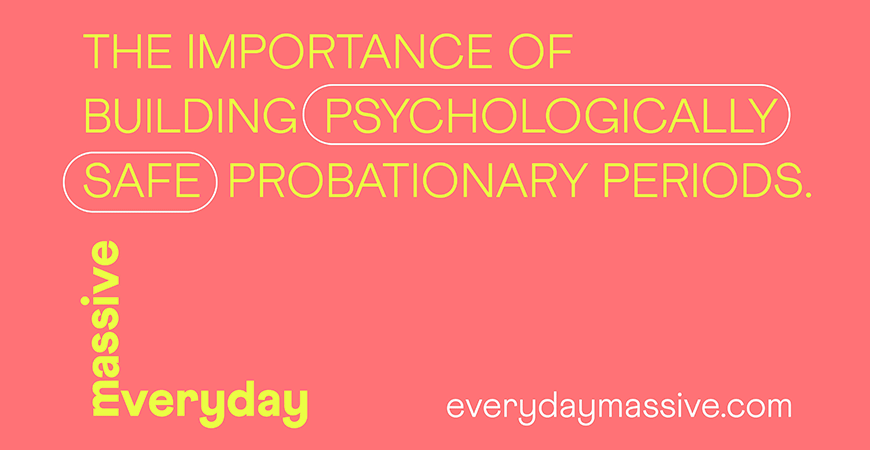The missing link in the onboarding experience.
This is part one of a three-part article series that sees D’Neale Prosser questioning the probationary process and the psychological safety that it lacks.
Psychological safety is like oxygen. When it’s in the room, we don’t even notice it. The second it’s gone, it’s all we notice.
The probationary period has an impact on psychological safety and is a missing link when designing your onboarding experience. There are ways to use comfort zones in the beginning phase of the employee lifecycle to improve learning, increase retention and build performance — leading to the successfully and swiftly passing through the probation period.
Starting a new job is a stressful situation. There are high hopes that it will all work out, however, there is a looming and persistent worry about losing the job.
A mistake or an awkward conversation can make the heart of a new employee pound and breath quicken, muscles tense and beads of sweat forming. This cascade of stress hormone production, physiological and psychological change is known as “fight-or-flight”.
New employees come to you with optimism, but also with a survival mechanism. Just like any other mammal ready to react quickly to any threatening situation. A carefully orchestrated onboarding experience with a high degree of psychological safety can help your new employee fight the threat of ‘not being everything you need them to be’ straight away and avoid fleeing to safety.
We have seen new employees go through the ‘try before you buy’unpaid trial, which often (thankfully) evolves into a paid trial. And then comes the probationary period, which still reeks of ‘congratulations you got the job, but you’re still on trial’. The new employee feels optimistic and hopeful, and there are many reasons they should be. But there is still an element of uncertainty and doubt.
The real question to ponder is: do we need probationary periods if we hire right?
Yes, there is a need to safeguard ourselves as employers if an employee is not a good fit or does not perform. But perhaps there are better alternatives. At the very least, by acknowledging the impact the probationary experience can have, and being aware that we have a duty of care to a new employee to waive it as soon as possible.
A new employee wants to form and maintain social relationships. One of the central desires of any human is to obtain social acceptance, and so many of our functions and activities are geared towards promoting that goal. So if we know that acceptance is key to building a sense of belonging and reassurance, then it becomes obvious that the probationary period can stifle the feeling of acceptance.
So how do we accelerate how soon a new employee feels accepted?
Consider how a hungry person may grow hungrier when food is denied but feels less hungry after a big meal. The same applies to feeling socially accepted. When someone receives feedback with a message of social acceptance, their motivation to build on those relationships is more likely to be satisfied, which should make them feel more at ease.
Therefore, the conversations throughout the probationary period should be centred around building acceptance, belonging, and reassurance. It’s on us as the leader to instigate those conversations, as a new employee is not going to reveal they are feeling unsafe. That only heightens the feeling of being under threat.
It is better to lead with acceptance, rather than ‘testing’ or ‘trialing’. This language can make or break the onboarding experience.
It is also worth considering how when people feel that there is the slightest of likelihood that they may be rejected, their desire to find acceptance may be intensified. This is a massive responsibility as an employer. We have a duty of care to a new employee to build a psychologically safe environment, even when they’re on probation.
As the employer, we are the decision-makers in the probationary period. Empathy is the most important leadership capability when leading a new employee. Remember what it was like to start a new job, have a new leader, learn new things, build new relationships and deliver in a new role, maybe in a new way or new industry. And all the while with the monkey on your back telling you that you are being judged and wondering whether you are right for the role or organisation.
A new employee, regardless of how excellent onboarding has been, will count down the weeks and days until probation is passed. As an employer, those weeks and days pass by, usually with little to no thought that the new employee is feeling that way.
So, let’s raise our awareness of the impact the probationary period has on a new employee, do things to proactively shake the ‘fight-or-flight’ feeling, and build meaningful relationships based on acceptance and empathy.
It is time to move away from the traditional probationary period and commit to delivering a better onboarding experience by building psychological safety. Keep following me on this movement – over the next two weeks, there will be a second and third article that will step you through how to build psychologically safe probationary periods that will improve your onboarding experience.
Stay tuned for Part 2: How to build psychologically safe probationary periods that will improve the onboarding experience.
Cover image: Source







